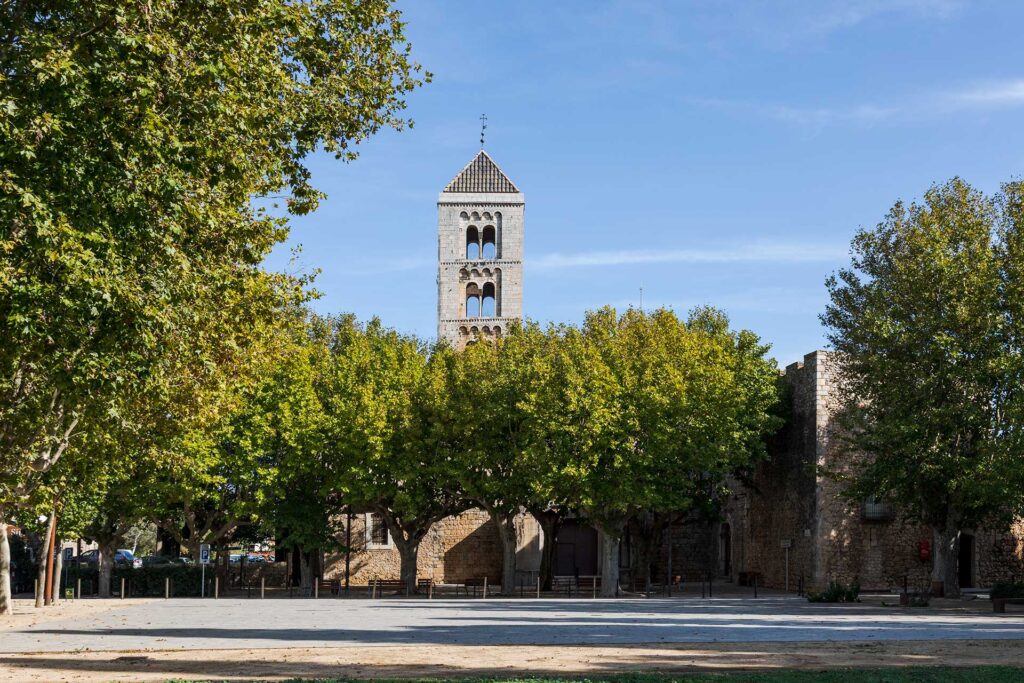
The emergence of the Santa Maria de Vilabertran Canonry is a symbol of the reform movement of the late 11th century which fought against the impositions of the nobility through ecclesiastical appointments. With this position, the priest Pere Rigau managed to bring together a community of chaplains who, in 1080, founded a monastery that would follow the rule of St Augustine and one which has left as a legacy of one of the best-preserved examples of medieval canonical architecture. The complex, built between the 12th and 13th centuries, was initially formed by a central cloister that led to the monastic quarters and the church. The church is the most outstanding element, particularly the processional cross inside, considered the largest piece of Gothic silver work in Catalonia. Later, the canonry was extended with the Rocabertí funeral chapel (from the 14th century), the Abbey’s Palace (from the 15th century) and the walled courtyard (from the 18th century) which housed the external buildings of the cloister.
Image from the Joaquim Fort collection from 1955, part of the Empordà Museum in Figueres, which shows the bell tower of the ancient monastery of Santa Maria de Vilabertran. The photograph shows the exterior constructions of the monastery, in the foreground. The monastery favoured an urban nucleus whose inhabitants had, in a certain way, a more or less close relation with the ecclesiastical institution.
Literary Text
Pensava en l’abat Rigall, que fundà el monestir al capvespre del segle onzè, a tocar de la font i el bassiol que ara és tancat, voltat d’àlbers centenaris. Entrant, a mà esquerra, encara tinc temps de rellegir les lletres capitals que ens informen que a la paret de tramuntana reposa l’abat Pere Rigall:
DISCAT QUI NESCIT PETRUS ABBAS HIC REQUIESCIT NEC TIMEAS FALLI PETRUS FUIT ISTE RIGUALLI
I pensava, també, en una altra música que ell de segur escoltava i cantava: les ondulacions del cant gregorià amb la seva mesura vivent i sinuosa, ara gairebé bandejat, al nostre país, del seu marc natural, i no substituït per res que se li pugui comparar. Sort que havia reservat la meva entrada, un dels seients B, a l’esvelta nau central, més alta que les altres dues, força endavant; l’església aviat s’omplí de gom a gom. [...] Tot aquest conjunt de circumstàncies i, per damunt d’elles, l’anunci de la primera audició d’un trio inacabat de Mozart, descobert pel violinista Climent Moragues, havia fet que el monestir resultés insuficient en esguard de l’allau de persones que haurien volgut encabir-s’hi. Molts restaren a fora, decebuts, tot mirant la bellíssima façana del palau de l’abat, amb les joies dels cinc finestrals gòtics d’esvelts mainells i la solidesa daurada dels murs emmerletats que féu bastir l’abat Antoni Girós. [...] les altes voltes, les columnes llises, sense escultures als capitells, amb l’única i suficient bellesa de la seva forma, els tres absis, els arcs de dovelles ben tallades i allisades, el presbiteri ja tot il•luminat... Moltes vegades els forasters sensibles s’informen més que la gent del país. Qui sap si coneix fins i tot la llegenda del bon abat Rigall, que un dia de tramuntana pujà dalt del campanar de tres pisos i, tot i arrapat al batall d’una campana, la tramuntana se l’endugué pels aires! Sort que l’amplària del seu hàbit es bufà tota ella, estarrufant-se amb el vent, com un globus burell, i l’abat volant com una gavina arribà a terra sa i estalvi.
Dins VIOLA D'AMORE, de Maria Àngels Anglada
Text published on the Espais Escrits mapaliterari.cat website. Catalan Literary Heritage Network.
Location
-
Plaça Dels Hortolans 4, 17760 Vilabertran, Provincia de Gerona, España


Add a review